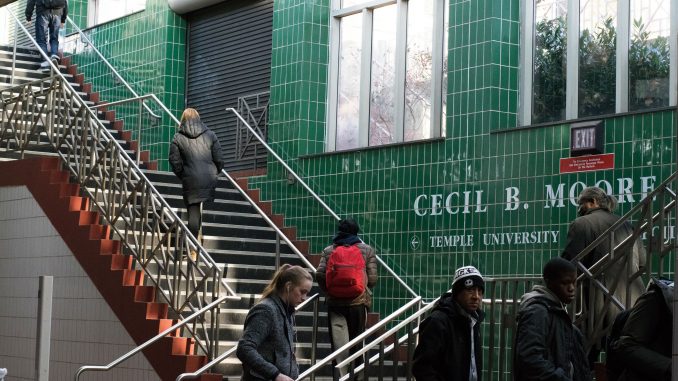
When Karen Asper-Jordan stands outside SEPTA’s Cecil B. Moore subway station near Main Campus, she reflects on the times she stood arm and arm with the civil rights leader, after whom the station is named.
Asper-Jordan is the head of the North Philadelphia community activist group called the Cecil B. Moore Philadelphia Freedom Fighters. The group is engaged in conversations with SEPTA to assist in changing the Cecil B. Moore station to better recognize Moore’s legacy and the surrounding neighborhood’s history.
On Nov. 21, the Freedom Fighters met with SEPTA representatives to share their thoughts on how to better represent Moore’s achievements into the station.
Francis Kelly, SEPTA’s assistant general manager of government and public affairs, and Robert Lund, the assistant general manager of engineering, maintenance and construction, were both present at the meeting.
“SEPTA hears our mission, but we haven’t always had the best relationship with them,” Asper-Jordan said. “They’ve done a lot of things that we weren’t pleased with or made aware of. I was not satisfied with the meeting. The conversations need to continue, because we are not in agreement.”
Asper-Jordan declined to comment on specific agenda items discussed at the meeting, but indicated that the two groups will convene again.
SEPTA and the Freedom Fighters have been negotiating plans for a memorial honoring Moore since August 2015, when Temple attempted to rebrand the Cecil B. Moore station as a part of its “Take Charge” initiative and posted advertisements on the exterior and interior of the stop. After elected officials and community residents expressed their disdain for the advertisements, they were removed and talks began between SEPTA and the Freedom Fighters.
“I have a lot of respect for what the Freedom Fighters are about,” Kelly said. “I have had many conversations with Karen, and they are a very spirited group. We are trying to give them the opportunity to do this.”
As part of the ongoing discussions, SEPTA proposed new signage, displaying Moore’s name in a more prominent font outside the station. It also proposed a historical marker on a brick wall inside the stop’s lobby — that area already features a mosaic depicting Moore, which is accompanied by a plaque.
SEPTA also suggested the use of urban panels, which are video boards placed atop subway entrances. At this station, the urban panel would display a slideshow of photos of Moore. The transportation company is giving the activist group the opportunity to submit content for the proposed screens.
Founded more than 50 years ago by the late activist Melvin “Mel” Dorn Shamlin, the group is committed to promoting racial equality.
Moore, who graduated with a Temple law degree in 1953, was an influential figure during the civil rights movement. Shamlin played an instrumental role in petitioning to name the street adjacent to the station in Moore’s honor.
Today, the Freedom Fighters consists of a core group of nearly 15 community residents.
Asper-Jordan assumed the helm of the organization after Shamlin’s passing in 2014.
“Cecil B. Moore was the most important person to live in North Philadelphia in the last 50 years,” said Molefi Kete Asante, professor and chair of the university’s Africology and African-American Studies department. “Students at Temple and community residents would all learn the same lesson from the station, and that is when you believe in something, and it changes the way people see themselves and society, then it is something worth fighting for.”
Asper-Jordan said the Freedom Fighters are concerned that the local community is forgetting the namesake of the station because the current mosaic and plaque installation is not easily visible. A station with new historical images on display would remind residents of the neighborhood’s history, she added.
“Can you imagine people seeing people that look like them on a photograph from years ago, that did something to make a better way?” Asper-Jordan said. “It would be such a pride-builder.”
Asper-Jordan hopes that members of the Temple community who use the subway station will be better educated about the struggle for racial equality that existed for many decades in North Philadelphia.
“Temple students can learn not only the history, but that people were there before they got there,” she said. “Families were there before Temple encroached on a lot of the land.”
“People who are transplanted into the community and are going to school here, they should know something about that subway stop,” she added. “They should know who Cecil B. Moore is. There’s a lot of history there.”



Be the first to comment